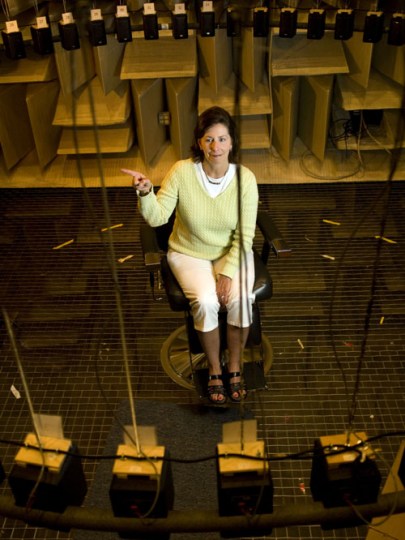
Wendy Lipscomb identifies the location of sounds in the anechoic chamber at the Bill Wilkerson Center. (photo by Susan Urmy)
Study tracks cochlear patients’ hearing ability
Vanderbilt Bill Wilkerson Center researchers are launching a study of patients with cochlear implants to track the development of hearing abilities within the first two years after surgery.
The study, partially funded by MED-EL (Medical Electronics) Corp., is seeking 18 adults to form two groups – one receiving an implant for each ear during a single surgery (simultaneous group) and the other receiving their second implant about one year after receiving the initial implant (sequential group).
Once the implant is activated, patients are tested after 1, 3, 6, 12, and 18 months.
“The first goal is to track how improvement proceeds over the first 18 months after the implant (or implants) are turned on,” said Wesley Grantham, Ph.D., professor of Hearing and Speech Sciences. “The second goal is to determine whether this improvement is different for those who have simultaneous implants from the improvement observed with unilaterally implanted patients.”
“We want to know if those who elect to get one now and one later catch up to the performance level of those who were implanted in a simultaneous surgery. It is of particular interest to know the time course of improvement for the two groups of patients and whether there is a long-term advantage for either the simultaneous or the sequential procedure.”
Candidates for implant surgery usually have a “profound” loss of hearing, meaning they wouldn’t be considered if even one of their ears has some useful hearing.
Cochlear implants have been available for nearly three decades to restore hearing for persons with profound hearing loss. The surgery for two implants takes about three hours.
Tennessee’s first dual cochlear implant surgery was performed at Vanderbilt in 2002 by Robert Labadie, M.D., Ph.D., assistant professor of Otolaryngology, and David Hayes, M.D., associate professor of Otolaryngology and director of the cochlear implant program.
The new study is a followup to “Spatial Hearing in Bilaterally Implanted Cochlear Implant Users,” which was conducted at Vanderbilt from 2001-2004 and tested 22 bilaterally implanted patients in tasks including localization and speech discrimination.
The second phase extends the study of hearing abilities to both unilaterally and bilaterally implanted patients.
“We received some good initial data from that study and decided for phase two that we would like to do a more in-depth longitudinal study,” Grantham said.
The choice between one or two implants is an individual decision that weighs factors such as cost, additional surgery and what new technologies may be available in the future.
Patients who enroll in the current study may choose which of the two groups they would like to be in.
Project sponsor MED-EL has agreed to cover the cost of the second implant for study participants if insurance doesn’t pay for it, Grantham said, so all participants will have dual implants by the end of the study.
“The disadvantage of having just one implant is impaired localization. You don’t have a good sense of space, of where sounds (voices, vehicle noises, footsteps, etc.) are coming from,” Grantham said.
“There’s also some evidence that, with one implant, you don’t understand speech as well in background noise. We feel it is important for the community to have this new information. For an individual it could help him or her decide whether to have two implants now or one now and one later.”
For more information call 936-5105 or e-mail d.wesley.grantham@vanderbilt.edu.













